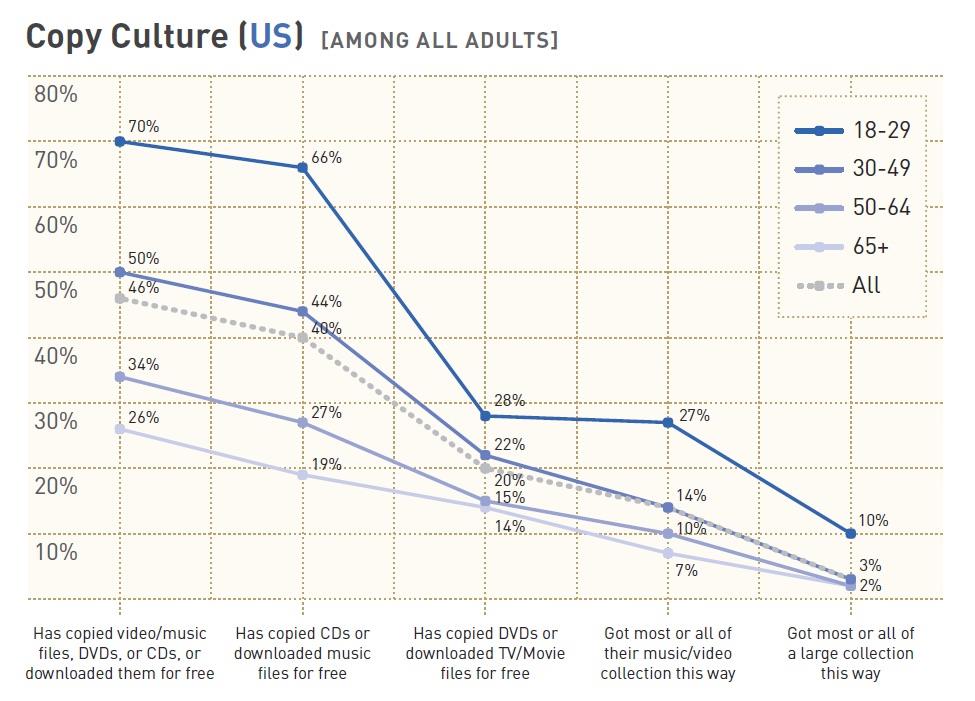Movie piracy isn’t going away, but neither are movies
The implications of illegal file sharing on movie content are not as cut-and-dry, considering the film industry seems to be thriving. 2015 was a record year for North American box office revenue, which exceeded US$11bn, a nine per cent increase year over year.
Notwithstanding the healthy ticket sales at the box office, it’s likely that video piracy has had some impact the industry. However, the influence is not as measurable or predictable as content producers would hope. It’s also possible the industry is being affected in ways more complex than just lost ticket sale opportunities.
Piracy takes various forms
Research corroborates there are far more watchers of pirated content than there are distributors. According to the study Copy Culture, published by The American Assembly at Columbia University, about one out of five adults in the US engage in some informal copying of DVDs or downloading of movies or TV files for free. However, the same report found that only eight per cent of Americans adults watch movies and TV from illegal streaming sites and a scant one per cent of are heavy copiers of movie and TV content.

The format and quality of pirated movies tend to vary based on their timing relative to the theatrical release window. Occasionally, illegal copies of movies get posted on the Internet before the film gets wide release in theatres (as was the case with The Expendables 3 and Fury). In these instances, the most likely culprits are copies stolen directly from movie studios or copies of leaked DVD screeners that are distributed to Academy Award voters. In either case, the reproduction quality is generally excellent.
During the first few weeks a film is shown in theatres, there’s a surge in piracy in the form of ‘cam’ copies, which involve the relatively low tech approach of sitting in a theatre with a camcorder pointed at the screen. Once a film is released on DVD months later, there’s a spike in high quality copies because pirates have easy access to a high resolution digital version they can duplicate for friends or upload to the web. An honors thesis study at Tufts University Department of Economics quantified the phenomenon when it found 94 per cent of leaks within one week of film release were cam and six per cent were DVD quality. Leaks that happened very early or late were 56 per cent cam and 44 per cent DVD quality.
Motivations for piracy
The Copy Culture report found the most cited reason for downloading movies and TV for free was viewers didn’t want to watch commercials (which presumably applies more to the TV content). The next most cited reasons were viewers had to wait too long to see the content legally and the legal versions were too expensive. In a recent Fortune magazine article, Are Movie Theatres to Blame for Illegal Downloading? the author observed, ‘Movie piracy is as much a response to the timing of demand as it is the pricing or any other factors.’ He believes that one of the primary reasons people watch pirated video is they don’t have convenient legal options for watching the movies where and when they want. This view is corroborated by a PriceWaterhouseCoopers study that found ‘82 per cent of consumers are willing to pay $10-$20 above the cost of a movie ticket to watch a newly released move in their homes.’

Forbes magazine concluded the growth of legal streaming video channels like Netflix and Amazon Prime has recaptured some of the viewers who would otherwise have turned to illegal options. Similarly, the Columbia University report found 63 per cent of respondents 30-49 reported they download illegal content less because of the emergence of legal video streaming alternatives. This phenomenon may not apply to hard copy DVD piracy in foreign markets but it appears to be a positive factor in the US.
Who gets hurt by movie piracy
Richard Gladstein, producer on the new Tarentino movie, The Hateful Eight, was a guest columnist in The Hollywood Reporter in early January. He claimed his film was viewed illegally online over a million times in the first two weeks after its theatrical release. He points a finger squarely at Google for not better enforcing copyrights on their search engine and YouTube sites. Meanwhile, the $44m film still grossed more than $48m domestically in its first three weeks.
Jean Prewitt, president of the Independent Film & Television observed, “The impact of piracy tends to play out differently and arguably more immediately on the independent sector than it does on the studios.” She explained, “Distributors are not able to take the risks they used to. What this means to the consumer is not that some producers don’t get rich, it means the product doesn’t get made.”
Millennium Films president Mark Gill was asked at Digital Entertainment World conference: what can be done to mitigate losses from video piracy? His recommendations were to shut off access that piracy sites have to advertising and payment processing; inform consumers about the risks of downloading pirated content (i.e., risks from malware and viruses); and educate consumers about how piracy can affect them directly.
Let’s also add to this list, keep providing appealing legal options for accessing content. It seems most people will do the right thing…particularly when it’s easy and convenient to do so.
More like this
How a UK film magazine became the biggest movie brand in the world







